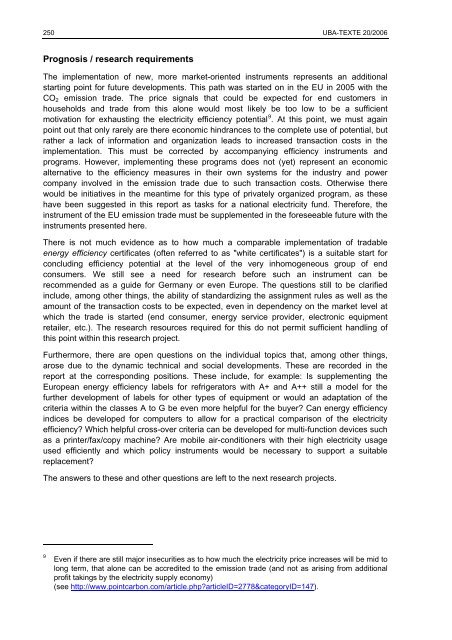Politikinstrumente zur Effizienzsteigerung von Elektrogeräten und ...
Politikinstrumente zur Effizienzsteigerung von Elektrogeräten und ...
Politikinstrumente zur Effizienzsteigerung von Elektrogeräten und ...
- Keine Tags gefunden...
Erfolgreiche ePaper selbst erstellen
Machen Sie aus Ihren PDF Publikationen ein blätterbares Flipbook mit unserer einzigartigen Google optimierten e-Paper Software.
250 UBA-TEXTE 20/2006Prognosis / research requirementsThe implementation of new, more market-oriented instruments represents an additionalstarting point for future developments. This path was started on in the EU in 2005 with theCO 2 emission trade. The price signals that could be expected for end customers inhouseholds and trade from this alone would most likely be too low to be a sufficientmotivation for exhausting the electricity efficiency potential 9 . At this point, we must againpoint out that only rarely are there economic hindrances to the complete use of potential, butrather a lack of information and organization leads to increased transaction costs in theimplementation. This must be corrected by accompanying efficiency instruments andprograms. However, implementing these programs does not (yet) represent an economicalternative to the efficiency measures in their own systems for the industry and powercompany involved in the emission trade due to such transaction costs. Otherwise therewould be initiatives in the meantime for this type of privately organized program, as thesehave been suggested in this report as tasks for a national electricity f<strong>und</strong>. Therefore, theinstrument of the EU emission trade must be supplemented in the foreseeable future with theinstruments presented here.There is not much evidence as to how much a comparable implementation of tradableenergy efficiency certificates (often referred to as "white certificates") is a suitable start forconcluding efficiency potential at the level of the very inhomogeneous group of endconsumers. We still see a need for research before such an instrument can berecommended as a guide for Germany or even Europe. The questions still to be clarifiedinclude, among other things, the ability of standardizing the assignment rules as well as theamount of the transaction costs to be expected, even in dependency on the market level atwhich the trade is started (end consumer, energy service provider, electronic equipmentretailer, etc.). The research resources required for this do not permit sufficient handling ofthis point within this research project.Furthermore, there are open questions on the individual topics that, among other things,arose due to the dynamic technical and social developments. These are recorded in thereport at the corresponding positions. These include, for example: Is supplementing theEuropean energy efficiency labels for refrigerators with A+ and A++ still a model for thefurther development of labels for other types of equipment or would an adaptation of thecriteria within the classes A to G be even more helpful for the buyer? Can energy efficiencyindices be developed for computers to allow for a practical comparison of the electricityefficiency? Which helpful cross-over criteria can be developed for multi-function devices suchas a printer/fax/copy machine? Are mobile air-conditioners with their high electricity usageused efficiently and which policy instruments would be necessary to support a suitablereplacement?The answers to these and other questions are left to the next research projects.9Even if there are still major insecurities as to how much the electricity price increases will be mid tolong term, that alone can be accredited to the emission trade (and not as arising from additionalprofit takings by the electricity supply economy)(see http://www.pointcarbon.com/article.php?articleID=2778&categoryID=147).
















